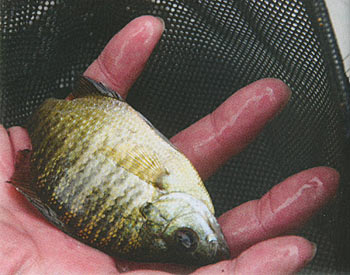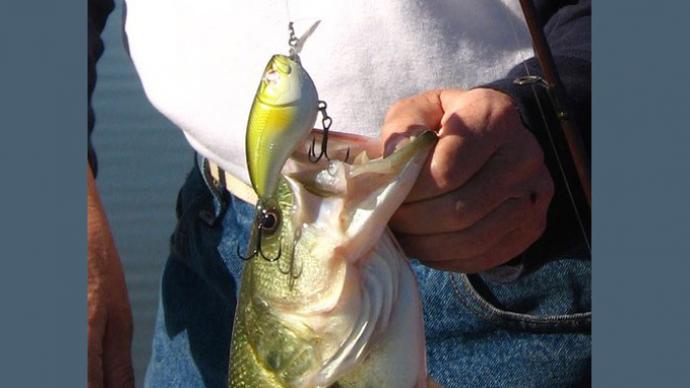
Frustrating—that's what it is.
You did everything right. Everything.
You built your small pond in the best place. The best soils are doing what they do, and holding water as you'd hoped. A good habitat design is now covered with plenty of water, and your fish are stocked. They are coming to the feeder, and by your best account, fish are growing surprisingly fast.
Then, it happens.
You decide to spend a few minutes sampling—for a close-up look at your precious creatures. With worm dirt under your nails, and a piece of nightcrawler trying to un-worm itself from your long-shanked bream hook, you toss this delectable offering toward the maw of hungry fish. The little bobber explodes in submersion as the fish soon submits to your four-pound test line and ultralight rig bent double.
Sunfish dangling, you look at it. It has a bigger mouth than you think it should. Its fins are trimmed in bright yellow. It seems a bit lanky, not deep-bodied as you thought your bluegill should look. You reach into the safety of your pocket, pull out your Smartphone, swipe it, get worm dirt on the screen, scroll to your photo setting, and shoot a couple of pictures.
As you keep fishing, 'er sampling, about a dozen fish are hooked, observed, and released. The rest of the batch look just like the photos you remember of what a bluegill should look like. Deep bodied, iridescent-colored fins, small mouth, black spot at the back base of the dorsal fin. But, that first one is bugging you.
Later, in your favorite chair, with a favorite beverage, you decide to hit the University of Google and see what gives about that solitary fish. Google sends you where it should, straight to the Pond Boss forum for a search.
Yep, those images look just like the fish in your photos.
A green sunfish.
You didn't stock it. How did it get there and what do you do about it?
First, shock hits you like a gut-punch, which is followed by a dose of mild anger, and then frustration takes over. How could this happen? Worse, will this mess up your well-laid plans? Your research suggests green sunfish will compete against your bluegills and could create a problem with your forage fish game plan.
The advice you find is to quantify the numbers as best you can. If you catch 20 fish, and two of them are the little greenies, or "rice field slicks" as Arkansas locals call them, is that a problem? What if 15 of 20 are those slimy little infidels?
As you make your way back to the dock, the feeder goes off. You see lots of little explosions, but those fish are too fast to tell what they are. But, you do notice several little green sunfish gliding to the surface to partake of the free meal. Then, a little black thing with a tail garners your attention. A dadgum bullhead catfish, not even three inches long, is partaking of your nutritious nuggets.
You cuss a little bit under your breath.
A little rush climbs up your spine. You think, "That hatchery truck messed up! Brought fish I didn't order." Your jaw is now clenched, and pinching off a piece of nightcrawler actually feels pretty good.

After you calm, and assess, you realize you caught zero green sunfish this time, only bluegills and some small bass.
So, is this a problem with your mini-pond? All your hard work, great thoughts, success management strategy plan, fish stocking, and the dollars you've spent—is all this for naught?
No, it isn't.
Actually, it's smart to expect to see something you didn't plan for and have a plan for it. Then, once you know what you have, ask for help to decide what to do.
In this more-than-hypothetical case as described, bass will eat green sunfish before they can establish. Did the fish truck stock them? Not likely. Any fish hatchery can't stay in business long if they do such dastardly deeds as stocking unwanted fish. Did birds carry and drop them into your pond? Probably not. Maybe a friend or neighbor stocked them? Could be, if you or any of your friends have bucket biology habits. Bullheads and green sunfish live in almost every watershed in this great nation, and they move about during heavy rain. Most likely, they came with water flow during a high-water event. The question now is what to do.
Job One is to figure out what you have. Learn about the life histories and lifestyles of these unwanted fish. Then, do your best to quantify. Do they outnumber your other fish? If so, you'll have a different decision to make than if there are just a few.
Don't panic, but think through it.
Job Two is to consider the source. If you had it to do over, is there anything you could have done to prevent these fish?
Last spring, I met up with a guy in southeastern Oklahoma. He'd built a nice, little oval-shaped pond in a low spot last summer. While he was at it, he had the bulldozer guy deepen the shoreline and remove a batch of silt from an older pond upstream in the hay pasture. As he contemplated stocking the new pond, we were discussing his options. I kept seeing what looked like little raindrops popping at the surface of the new pond. He had a lightweight spinning rig with a popping bug in the bed of his pickup. I grabbed it, tossed it toward a little ripple, and heard a sucking noise just at the bug disappeared. In five casts, I caught five little palm-sized green sunfish. He looked astonished. "Where did those things come from?" We climbed in his rig and drove toward the old, partially renovated pond. Same thing, popping bug, bigger green sunfish. I asked, "When the dozer moved this dirt, was there any water left in the pond?" There was.
Even with a few inches of water, some species offish can live.
So, for the new pond, I took him in a different direction than what either of us planned. His choices were to renovate or stock and manage around the existing fish.
Here are your take home points for this scenario.
First, think beyond the obvious during your planning and construction phase. Make no assumptions. Deal with facts. If there's a puddle in a low spot, check it for fish. If a neighbor has a pond in your watershed, find out what's in it, or plan to design a program to accommodate that distinct possibility.
If you find out there are some unwanted fish, don't automatically assume that it's bad. Chances are, you can overwhelm them with good fish, depending on the circumstances.
The biggest tip? Don't panic. Think through what you have, gather more knowledge, and then choose what to do about your dilemma. A mini-pond is the easiest of all pond types to change direction. These little water bodies can be changed in hours, and your job is to figure out if change is necessary, and if so, what is the best change to get you on the track to meet your goals and expectations.
Oh, the guy with the green sunfish in the new pond? He decided to turn that lemon into lemonade. He bought some larger bluegills, began feeding all the fish, and once he found baby bluegills, he stocked some 10- to 12-inch bass to begin cleaning up the green sunfish. That size class of bass have the mouth size to eat those 3-inch little tenders. He plans to let the bass do the dirty work, knowing that green sunfish spawn once yearly, while bluegills spawn several times in his part of the planet. With bass eating them, green sunfish numbers will soon be overwhelmed by bluegill reproduction.
Reprinted with permission from Pond Boss Magazine



